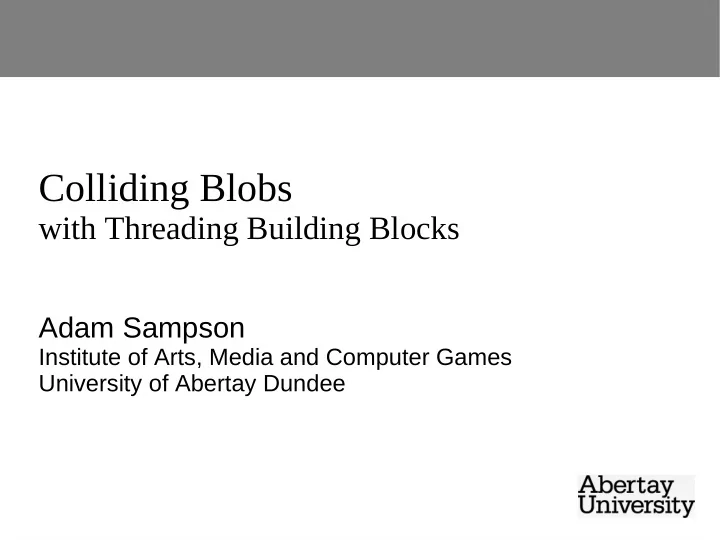

Colliding Blobs with Threading Building Blocks Adam Sampson Institute of Arts, Media and Computer Games University of Abertay Dundee
Motivation ● MSc projects this summer simulating physical interactions between cells in a tissue – All-pairs, computing forces between elements – … at least to start with ● They're interested in parallelising it, but they've not done any parallel programming before... how well is this likely to work? ● Try a really simple approach to parallelisation – what the tutorials tell you to do!
Implementation ● All-pairs nbody in C++0x ● Write readable code and see how well the compiler does – … but I'll measure this later – Hints: inlining, const annotations... ● Liberal use of the standard library and of Boost ● 3D vector class ● All templated over scalar/vector types: universe<vec3<float>>
Benchmarking ● Benchmarked on several different machines ● run-tests script for automated benchmarking – Vary compiler options – Vary runtime options – Vary number of threads – Produce data and config files for gnuplot ● Ensured no memory pressure, and profiled to confirm I was timing the appropriate bit – … not very hard with this problem!
Compiler options ● Tune for appropriate architecture – -march=core2 , etc. (implies -mtune ) ● Try 387 maths vs. SSE maths – -mfpmath=387 , -mfpmath=sse ● Try -O2 , -O3 , -Os – Optimising for size used to be a good idea on cache-starved CPUs...
Vector representation ● Conventional implementation, templated over scalar type (both float and double) template<typename T> class vec3 { ... vec3<T>& operator+=(const vec3<T>& o) { x_ += o.x_; y_ += o.y_; z_ += o.z_; return *this; } ...
Vector representation ● … or implementation using the SSE intrinsics ● Alignment problems with std::vector – Use tbb::cache_aligned_allocator class vec { // just a _m128 really ... vec& operator+=(const vec& o) { v_ = _mm_add_ps(v_, o.v_); return *this; } ...
Results -O3 with SSE math and SSE vec class wins (no great surprise!)
An aside on std::vector ● There's a persistent myth (especially in the games world) that “the STL is slow” – (Note that some myths are true...) ● For a good compiler, this is not the case – vector should behave identically to an array... – VC++ is not a good compiler ● In the sequential nbody, GCC's optimiser inlines everything – you get one large function in the generated code
Machines ● Atom N270 1.6GHz, 1 core ● Core i7-2600 3.4Ghz, 4 cores ● 2x Xeon E5520 2.27GHz. 4 cores ● All cores 2x HT ● Debian, GCC 4.4, TBB 3.0
Machine performance
Data int nbodies_; // Keep positions packed together for better cache // usage above. // CAA gets us enough alignment for SSE to work. std::vector<V, tbb::cache_aligned_allocator<V>> pos_; std::vector<V, tbb::cache_aligned_allocator<V>> vel_; // This doesn't need to be aligned, but it doesn't hurt. std::vector<S, tbb::cache_aligned_allocator<S>> mass_; // FIXME: try different storage layouts
Triangular advance void advance_tri() { for (int i = 0; i < nbodies_; ++i) { for (int j = i + 1; j < nbodies_; ++j) { V d(pos_[i] - pos_[j]); S distance(d.mag(soften_)); S mag(dt_ / (distance * distance * distance)); vel_[i] -= d * (mass_[j] * mag); vel_[j] += d * (mass_[i] * mag); } } for (int i = 0; i < nbodies_; ++i) { pos_[i] += vel_[i] * dt_; } }
Tweaked triangular advance void advance_tri_cache() { const S soften(soften_); const S dt(dt_); for (int i = 0; i < nbodies_; ++i) { for (int j = i + 1; j < nbodies_; ++j) { const V d(pos_[i] - pos_[j]); const S distance(d.mag(soften)); const S mag(dt / (distance*distance*distance)); vel_[i] -= d * (mass_[j] * mag); vel_[j] += d * (mass_[i] * mag); } } for (int i = 0; i < nbodies_; ++i) { pos_[i] += vel_[i] * dt; } }
Square advance void advance_sq() { for (int i = 0; i < nbodies_; ++i) { V vel(vel_[i]); for (int j = 0; j < nbodies_; ++j) { if (i == j) { continue; } V d(pos_[i] - pos_[j]); S distance(d.mag(soften_)); S mag(dt_ / (distance * distance * distance)); vel -= d * (mass_[j] * mag); } vel_[i] = vel; } for (int i = 0; i < nbodies_; ++i) { pos_[i] += vel_[i] * dt_; } }
Mode results
TBB square advance class sq_tbb_worker { public: sq_tbb_worker(universe& u) : u_(u) {} void operator()(tbb::blocked_range<int> &r) const { for (int i = r.begin(); i < r.end(); ++i) { ... update velocities as before } } private: universe& u_; }; friend class sq_tbb_worker; void advance_sq_tbb() { tbb::blocked_range<int> r(0, nbodies_); sq_tbb_worker worker(*this); tbb::parallel_for(r, worker); ... update positions as before
TBB vs. sequential
TBB square results
TBB triangular results – spinning
OpenMP square advance void advance_sq_omp() { #pragma omp parallel for for (int i = 0; i < nbodies_; ++i) { V vel(vel_[i]); for (int j = 0; j < nbodies_; ++j) { if (i == j) { continue; } V d(pos_[i] - pos_[j]); S distance(d.mag(soften_)); S mag(dt_ / (distance * distance * distance)); vel -= d * (mass_[j] * mag); } vel_[i] = vel; } for (int i = 0; i < nbodies_; ++i) { pos_[i] += vel_[i] * dt_; } }
OpenMP results – argh!
OpenMP results trimmed
Any questions? ● Thanks for listening! ● Get the code: git clone http://offog.org/git/sicsa-mcc.git ● Contact me or get this presentation: http://offog.org/ ● Threading Building Blocks http://threadingbuildingblocks.org/
Recommend
More recommend